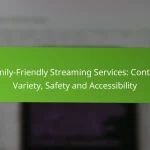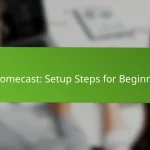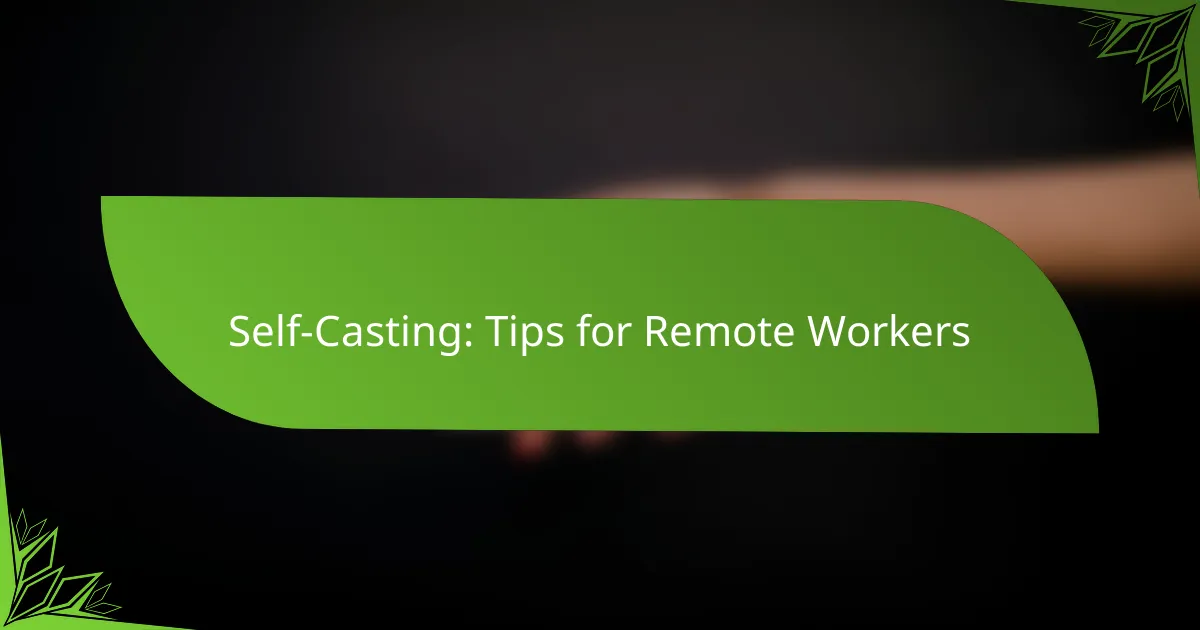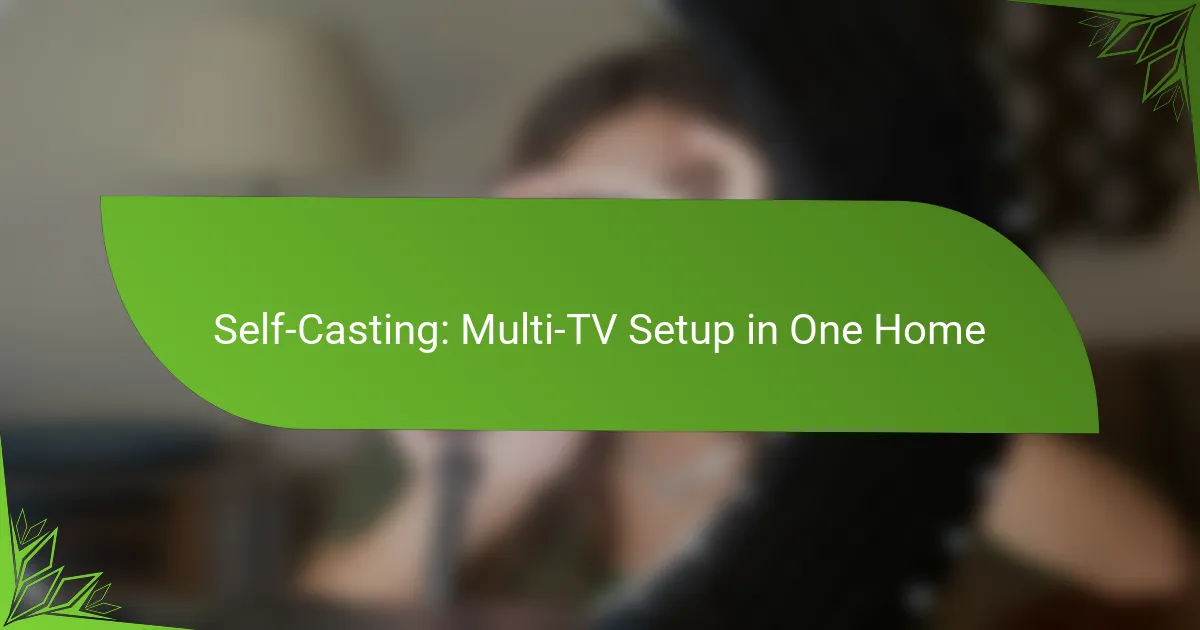Self-casting has become an essential skill for remote workers, allowing them to communicate effectively and present professionally in a virtual environment. By focusing on key elements such as audio quality, lighting, and camera positioning, individuals can significantly enhance their video calls and broadcasts. Understanding the right tools and addressing potential challenges will help create a polished and engaging online presence.

What are the best self-casting tools for remote workers?
The best self-casting tools for remote workers include software that enables high-quality video streaming and recording. These tools vary in features, ease of use, and compatibility with different platforms, making it essential to choose one that fits your specific needs.
OBS Studio
OBS Studio is a free and open-source software that allows users to capture and stream video content easily. It supports various platforms and offers advanced features like scene composition and audio mixing, making it suitable for both beginners and experienced users.
To get started with OBS, download the software from the official website, set up your scenes, and configure your audio and video settings. Be aware that it may require a learning curve, so consider watching tutorials to maximize its potential.
Streamlabs
Streamlabs is a user-friendly streaming tool that integrates with OBS Studio, offering additional features like customizable overlays and alerts. It is particularly popular among gamers and content creators for its ease of use and built-in monetization options.
Streamlabs provides a streamlined setup process, making it ideal for those new to self-casting. However, some advanced features may require a subscription, so evaluate your needs before committing to paid options.
Wirecast
Wirecast is a professional-grade live streaming software that supports multiple cameras and advanced production capabilities. It is suitable for businesses and organizations that require high-quality broadcasts and more control over their streaming environment.
While Wirecast offers powerful features, it comes with a higher price tag compared to other tools. Consider your budget and the level of production quality you need before choosing this option.
Zoom
Zoom is primarily known for video conferencing but also offers self-casting capabilities. It allows users to record meetings and webinars, making it a convenient choice for remote workers who need to share presentations or training sessions.
To use Zoom for self-casting, simply schedule a meeting, enable recording, and share your screen. While it may not offer the same level of customization as dedicated streaming software, its familiarity and ease of use make it a practical option.
Microsoft Teams
Microsoft Teams is another collaboration tool that includes self-casting features. It allows users to record meetings and share content, making it suitable for team presentations and training sessions.
Using Teams for self-casting is straightforward; just start a meeting, share your screen, and record. However, like Zoom, it may lack advanced streaming features, so assess whether its capabilities meet your specific requirements.

How can remote workers improve their self-casting setup?
Remote workers can enhance their self-casting setup by focusing on key elements such as audio quality, lighting, camera positioning, and internet speed. These factors significantly impact the clarity and professionalism of video calls and broadcasts.
Invest in quality microphones
Using a high-quality microphone can dramatically improve audio clarity during remote work. Consider options like USB or XLR microphones, which are known for their superior sound quality compared to built-in laptop mics.
Look for microphones with noise-canceling features to minimize background sounds. Popular models range from $50 to $300, depending on the quality and brand.
Use proper lighting
Good lighting is essential for creating a professional appearance on camera. Natural light is ideal, but if that’s not available, invest in softbox or ring lights that provide even illumination.
Aim for a lighting setup that minimizes shadows on your face. Position lights at a 45-degree angle to your face for the best results, ensuring your features are well-lit without harsh contrasts.
Optimize camera placement
Camera placement can influence how you appear on video. Position your camera at eye level to create a more engaging and natural interaction with your audience.
Ensure the camera is at least an arm’s length away to capture your upper body and facial expressions clearly. Avoid placing it too low or too high, as this can distort your image and create an unflattering angle.
Enhance internet connection
A stable internet connection is crucial for seamless video calls. Aim for a minimum upload speed of 3 Mbps for standard video quality, but higher speeds are recommended for HD streaming.
Consider using a wired Ethernet connection instead of Wi-Fi for more reliability. If Wi-Fi is your only option, position your router close to your workspace to minimize interference and maximize signal strength.

What are the common challenges in self-casting for remote workers?
Self-casting for remote workers often involves navigating technical issues, managing distractions, and engaging an audience effectively. These challenges can hinder productivity and the quality of presentations if not addressed properly.
Technical difficulties
Technical difficulties can arise from unreliable internet connections, inadequate hardware, or software glitches. Remote workers should ensure they have a stable internet connection, preferably wired, and test their equipment before starting any self-casting session.
Investing in quality microphones and cameras can significantly enhance the viewing experience. Regularly updating software and familiarizing oneself with the tools being used can also prevent last-minute issues.
Distractions at home
Home environments often present numerous distractions, such as family members, pets, or household chores. To minimize these interruptions, remote workers should establish a dedicated workspace and set clear boundaries with others in the household during self-casting sessions.
Using noise-canceling headphones can help maintain focus, while scheduling specific times for self-casting can create a routine that reduces the likelihood of distractions. Communicating your schedule to others can further enhance concentration.
Managing audience engagement
Engaging an audience while self-casting can be challenging, especially without immediate feedback. Remote workers should consider using interactive tools, such as polls or Q&A sessions, to foster participation and keep viewers interested.
Maintaining eye contact with the camera and using expressive body language can also help create a connection with the audience. Practicing active listening and responding to comments in real-time can enhance engagement and make the experience more interactive.

What are the best practices for effective self-casting?
Effective self-casting involves careful planning, audience engagement, and practiced delivery. By focusing on these key areas, remote workers can enhance their online presentations and ensure clear communication.
Plan your content
Planning your content is crucial for effective self-casting. Start by outlining your main points and organizing them logically to maintain flow. Use bullet points or numbered lists to highlight key ideas, making it easier for your audience to follow along.
Consider the length of your presentation; aim for a duration that keeps your audience engaged without overwhelming them. Generally, 20-30 minutes is a good target for most online sessions, allowing time for questions and interaction.
Engage with your audience
Engaging with your audience is essential for maintaining interest and fostering interaction. Use open-ended questions to encourage participation and invite feedback throughout your presentation. This not only makes your audience feel valued but also helps clarify any misunderstandings in real-time.
Utilize interactive tools like polls or chat features to create a dynamic experience. For instance, platforms like Zoom or Microsoft Teams offer built-in options for audience engagement, which can significantly enhance the overall effectiveness of your self-casting.
Practice your delivery
Practicing your delivery is key to ensuring a smooth presentation. Rehearse your content multiple times to build confidence and refine your timing. Record yourself to identify areas for improvement, such as pacing, tone, and clarity.
Consider conducting a mock presentation with a colleague or friend to receive constructive feedback. This practice can help you adjust your delivery style and address any technical issues before the actual self-casting event.










